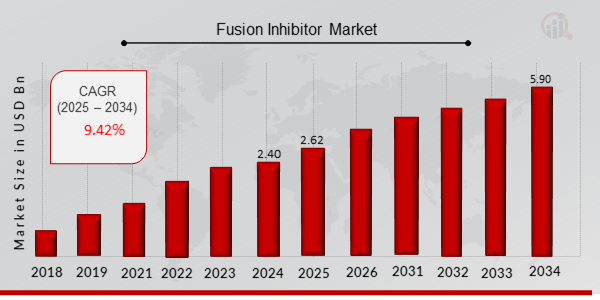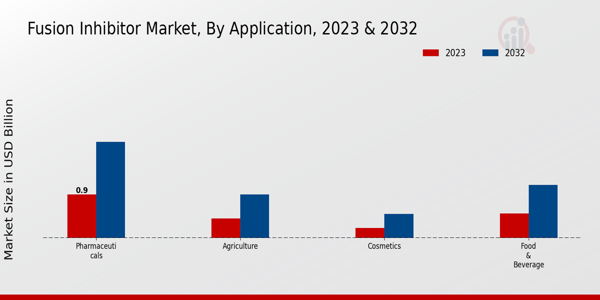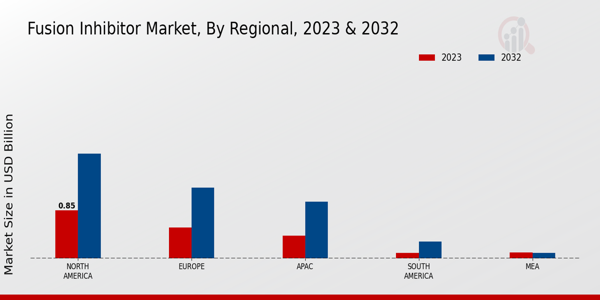Fusion Inhibitor Market Overview
As per MRFR analysis, the Fusion Inhibitor Market Size was estimated at 2.40 (USD Billion) in 2024. The Fusion Inhibitor Market Industry is expected to grow from 2.62 (USD Billion) in 2025 to 5.90 (USD Billion) till 2034, at a CAGR (growth rate) is expected to be around 9.42% during the forecast period (2025 - 2034).
Key Fusion Inhibitor Market Trends Highlighted
The Fusion Inhibitor market is witnessing significant growth influenced by various key market drivers. The increasing prevalence of viral infections has heightened the demand for effective antiviral treatments, leading to a rise in research and development for fusion inhibitors. Additionally, advancements in biotechnology and pharmaceuticals are driving innovations in drug formulations and delivery systems. The growing interest in personalized medicine is also encouraging the exploration of fusion inhibitors that target specific viral mechanisms, which can lead to more effective therapies. There are notable opportunities to be explored in this market.
The ongoing collaborations between pharmaceutical companies and research institutions can accelerate the development of novel fusion inhibitors. Expansion into emerging markets presents a chance to tap into populations that lack access to advanced antiviral therapies, creating a demand for affordable and effective treatment options. There is potential to enhance clinical trial designs to improve the understanding of drug efficacy, thereby increasing the approval rates for fusion inhibitors. Recent trends indicate a shift towards combination therapies that include fusion inhibitors as part of broader treatment regimens. Regulatory bodies are becoming more supportive of expedited pathways for antiviral drug approvals, promoting faster access for patients in need.
Moreover, the growing emphasis on drug repurposing has opened avenues for existing medications to be evaluated for their efficacy as fusion inhibitors. This trend not only speeds up the availability of treatments but also maximizes the use of established compounds, enhancing their market potential. Overall, the Fusion Inhibitor market is evolving rapidly, shaped by innovative research and changing healthcare needs. The intersection of technology and medicine continues to drive this market forward, while the commitment to improving patient outcomes remains a core focus for developers and healthcare providers alike.

Source: Primary Research, Secondary Research, MRFR Database and Analyst Review
Fusion Inhibitor Market Drivers
Increasing Prevalence of Viral Infections
The rise in viral infections globally has become a significant driver for the Fusion Inhibitor Market Industry. With the ongoing challenges posed by various viruses, including those responsible for serious health conditions, the need for effective antiviral treatments has never been more crucial. Fusion inhibitors play an important role in the therapeutic landscape, specifically targeting viral entry mechanisms. As healthcare systems around the world strive to develop effective medications, the research and development of fusion inhibitors is gaining momentum.
The increasing focus on antiviral therapies not only reflects the current health priorities but also aligns with the active roles of pharmaceutical companies in bringing innovative treatments to market. Additionally, ongoing clinical trials and the approval of new fusion inhibitors are integral in shaping the future of the Fusion Inhibitor Market Industry, as they enhance the treatment arsenal available to healthcare professionals and patients.
The growing urgency among healthcare providers to find viable solutions to combat viral outbreaks contributes to an expanding market for these therapeutic agents. With growing awareness of novel and existing viral diseases, there is a corresponding increase in patient demands for effective drugs, thereby positively influencing the growth trajectory of the market. Moreover, governments and health organizations allocate funds towards research initiatives aimed at understanding viral mechanisms and improving therapeutic options, creating a favorable environment for fusion inhibitors.
As new fusion inhibitors come to the forefront, they not only offer new hope for patients but also attract substantial investments from stakeholders, further driving the market. This dynamic interplay of patient demand, research push, and funding support makes the increasing prevalence of viral infections a key market driver.
Technological Advancements in Drug Development
Technological advancements in drug development have significantly contributed to the growth of the Fusion Inhibitor Market Industry. Innovations in biotechnology, genomics, and drug design methodologies have enabled researchers to identify and develop more effective fusion inhibitors with enhanced specificity and reduced side effects. The integration of artificial intelligence and machine learning in drug discovery processes is streamlining research, allowing for faster and more efficient development of antiviral medications.
These technologies facilitate the identification of new drug candidates by predicting their efficacy and potential interactions, consequently increasing the success rate of new therapeutic agents entering the market. As these advancements continue to reshape the pharmaceutical landscape, they enhance the prospects for fusion inhibitors to address complex viral mechanisms effectively. Furthermore, collaborative efforts between academic institutions and the pharmaceutical industry are fostering an environment of innovation, enriching the research pipeline for new fusion inhibitors.
Growing Investment in Research and Development
The growing investment in research and development (R) within the pharmaceutical sector is a prominent driver for the Fusion Inhibitor Market Industry. As healthcare stakeholders recognize the importance of addressing viral infections and the need for novel treatment options, funding for R initiatives is ramping up accordingly. This financial support facilitates the exploration of innovative therapeutic approaches, leading to the discovery of advanced fusion inhibitors.
Investments in R not only enhance pharmaceutical companies' capabilities to develop groundbreaking treatments but also encourage collaboration with academic institutions, biotechnology firms, and research organizations. Such partnerships are essential for leveraging cutting-edge technology and scientific expertise, resulting in a more robust pipeline for fusion inhibitors. The influx of capital into this area demonstrates the optimistic outlook on the future of antiviral therapies, ensuring that the market for fusion inhibitors remains dynamic and responsive to emerging healthcare demands.
Fusion Inhibitor Market Segment Insights:
Fusion Inhibitor Market Application Insights
The Fusion Inhibitor Market is witnessing significant growth across various applications, with the market expected to reach a valuation of 2.01 USD Billion in 2023 and further escalating towards 4.5 USD Billion by 2032. Within this expansive market landscape, the Pharmaceuticals segment dominates the Fusion Inhibitor Market segmentation, with a valuation of 0.9 USD Billion in 2023, set to grow to 2.0 USD Billion by 2032. This substantial value underlines the critical role of fusion inhibitors in drug development and therapeutic applications, illustrating their importance in addressing various health issues.
The Agriculture sector also contributes notably, valued at 0.4 USD Billion in 2023 and projected to reach 0.9 USD Billion by 2032. The use of fusion inhibitors in agricultural practices showcases their effectiveness in pest control and protection against plant diseases, marking their growing importance in promoting sustainable farming practices. The Cosmetics segment, while smaller, reflects an emerging trend, valued at 0.2 USD Billion in 2023 and anticipated to reach 0.5 USD Billion in 2032. This indicates a rising consumer interest in products that utilize fusion inhibitors for enhanced skincare and beauty solutions.
Meanwhile, the Food Beverage application segment holds a valuation of 0.51 USD Billion in 2023, projected to grow to 1.1 USD Billion by 2032, demonstrating their significance in food preservation and safety, which is vital amid increasing consumer demand for health-conscious products. Each application within the Fusion Inhibitor Market showcases unique opportunities driven by advancements in technology and growing end-user demands, fostering a landscape rich with potential and competition. The convergence of these applications results in comprehensive growth opportunities, validating the necessity of fusion inhibitors across various industries in enhancing efficacy and performance.
Overall, while Pharmaceuticals remain the majority holding in terms of market value, the emerging trends in Agriculture, Cosmetics, and Food Beverage underscore the expanding horizons of the Fusion Inhibitor Market, paving the way for innovative applications and significant market growth ahead.

Source: Primary Research, Secondary Research, MRFR Database and Analyst Review
Fusion Inhibitor Market Type Insights
Fusion InhibitorA key aspect of the market segmentation lies in its Type, which comprises various categories, including Small Molecule Inhibitors, Monoclonal Antibodies, Peptide Inhibitors and Bioconjugates. Each type plays a crucial role in addressing viral infections by blocking the fusion process, with Small Molecule Inhibitors often recognized for their versatility and ease of synthesis, paving the way for rapid drug development.
Monoclonal Antibodies dominate due to their high specificity and potential for tailored therapies, making them foundational in modern treatment regimens. Meanwhile, Peptide Inhibitors are gaining traction for their ability to target specific viral proteins effectively. Bioconjugates combine the benefits of various therapeutic classes, enhancing delivery and efficacy. The overall market is propelled by a rise in chronic diseases and a growing demand for advanced therapeutic options, while challenges include stringent regulatory requirements and high research costs.
The Fusion Inhibitor Market statistics underline a promising outlook driven by innovative research and the need for effective antiviral treatments.
Fusion Inhibitor Market End Use Insights
Fusion Inhibitorend-uEach of these areas contributes significantly to the market's dynamics, with Research Laboratories leading in innovation and exploration of fusion inhibitors for research purposes. Biotechnology Companies play a crucial role, focusing on developing advanced therapeutic solutions, thereby driving growth within this segment. Pharmaceutical Companies significantly influence the market by integrating fusion inhibitors into drug development, aiming to address various viral infections.
As these segments evolve, they present substantial opportunities for the Fusion Inhibitor Market revenue, supported by increasing investments in research and development and advancements in technology. However, challenges such as regulatory hurdles and competition for resources may affect the pace of growth. The Fusion Inhibitor Market statistics underscore robust demand within these sectors, pointing towards a healthy and expanding industry landscape.
Fusion Inhibitor Market Formulation Type Insights
Fusion InhibitorThis market is segmented by formulation type, primarily encompassing Liquid Formulation, Solid Formulation, and Gel Formulation. Each formulation type serves distinct therapeutic needs; for instance, Liquid Formulation is often preferred due to its easy administration and rapid absorption, making it particularly significant in acute therapeutic scenarios. Solid Formulation tends to dominate market preferences owing to its stability, extended shelf life, and convenience, appealing to patients who prefer less frequent dosing.
Gel Formulation has also emerged as a popular choice due to its localized application and reduced systemic side effects, catering to specialized treatment areas. The Fusion Inhibitor Market industry is driven by advancements in pharmaceutical technologies and increasing investments in research and development, while challenges remain in ensuring product efficacy and safety. Overall, the diverse formulation types contribute substantially to the Fusion Inhibitor Market revenue, highlighting the importance of tailored solutions to meet the varied demands of patients and healthcare professionals alike.
Fusion Inhibitor Market Regional Insights
Fusion InhibitorNorth America holds the majority share, valued at 0.85 USD Billion in 2023, and is expected to reach 1.85 USD Billion by 2032, showcasing its dominant position in the market. Europe follows closely, valued at 0.55 USD Billion in 2023 and is projected to achieve 1.25 USD Billion in 2032, driven by increasing research and technological advancement. The APAC region, valued at 0.4 USD Billion in 2023, is witnessing considerable interest, with growth expected to reach 1.0 USD Billion by 2032, highlighting its emerging market status.
South America and MEA represent smaller markets, valued at 0.1 USD Billion and 0.11 USD Billion in 2023, respectively. South America is projected to grow to 0.3 USD Billion, while MEA is expected to stabilize around 0.1 USD Billion by 2032. The varied market growth reflects unique regional demands, healthcare investments, and innovation potential, indicating numerous opportunities and challenges ahead, thereby presenting a dynamic landscape for stakeholders in the Fusion Inhibitor Market industry.

Source: Primary Research, Secondary Research, MRFR Database and Analyst Review
Fusion Inhibitor Market Key Players and Competitive Insights:
The competitive landscape of the Fusion Inhibitor Market is characterized by a diverse array of players, each striving to gain a foothold and enhance their market share. Fusion inhibitors have emerged as a crucial element in antiviral therapy, particularly against various viral infections. The market has seen significant advancements and innovations driven by the growing demand for effective treatment options. This area of pharmaceutical research has attracted considerable investment, enabling companies to innovate and improve their product pipelines. The dynamics of the market are shaped by factors like technological advancements, regulatory frameworks, and the ongoing need for new therapies to combat viral diseases. Competition is fierce, with a blend of established pharmaceutical giants and emerging biotech firms vying for leadership.
Roche has established itself as a formidable entity within the Fusion Inhibitor Market, leveraging its deep expertise in biotechnology and a comprehensive portfolio of products. The company's strength lies in its significant investment in research and development, which has led to the discovery of novel fusion inhibitors that hold promise in treating viral infections. Roche's extensive global presence allows it to not only tap into various markets but also collaborate with healthcare providers and researchers to enhance treatment protocols. The company's commitment to innovation and patient-centric solutions underscores its role as a leader in addressing the complexities of viral diseases. Its ability to adapt to changing market demands and invest in breakthrough therapies demonstrates its resilience and strategic positioning in a competitive arena.
Pfizer presents a strong competitive stance in the Fusion Inhibitor Market, known for its robust research capabilities and a history of successful drug development. The company's ongoing efforts in antiviral research embody its strategic focus on pivotal therapeutic areas where there is a significant unmet medical need. Pfizer's extensive resources and commitment to innovation enable it to maintain a competitive edge by rapidly advancing its pipeline of fusion inhibitors. The company's strong relationships with regulatory authorities and healthcare professionals facilitate streamlined market access for new products, enhancing its ability to respond to emerging health threats. Furthermore, Pfizer's global reach and marketing prowess contribute significantly to its presence in the fusion inhibitor landscape, allowing it to deliver state-of-the-art treatment options to healthcare practitioners and patients worldwide.
Key Companies in the Fusion Inhibitor Market Include:
- Roche
- Pfizer
- BristolMyers Squibb
- Eli Lilly
- Regeneron Pharmaceuticals
- Celgene
- Johnson and Johnson
- Vertex Pharmaceuticals
- AstraZeneca
- Amgen
- Gilead Sciences
- AbbVie
- Merck and Co
- Novartis
- Sanofi
Fusion Inhibitor Industry Developments
Recent developments in the Fusion Inhibitor Market reflect significant advancements among key players, including Roche, Pfizer, and Bristol-Myers Squibb. New clinical trials indicating the efficacy of innovative fusion inhibitors have bolstered investor interest, driving market valuations upwards. Eli Lilly and Regeneron Pharmaceuticals have also unveiled promising preliminary results from their ongoing studies, suggesting enhanced treatment options for various diseases linked to fusion processes. In terms of mergers and acquisitions, substantial activities have been noted, particularly with Amgen and Gilead Sciences exploring potential strategic alliances to expand their portfolios in this sector. Firms like AbbVie and Merck Co. have seen growth spurred by recent product launches, which are contributing positively to market dynamics.
Moreover, collaborations between Sanofi and Novartis aim to streamline research efforts, potentially accelerating drug development in the fusion inhibitor domain. The competition remains robust as AstraZeneca and Vertex Pharmaceuticals implement new strategic initiatives, further stimulating market growth and innovation. Collectively, these movements illustrate a vibrant market landscape, with ongoing shifts driven by clinical discoveries, collaborative ventures, and strategic expansions among industry leaders.
Fusion Inhibitor Market Segmentation Insights
Fusion Inhibitor Market Application Outlook
- Pharmaceuticals
- Agriculture
- Cosmetics
- Food Beverage
Fusion Inhibitor Market Type Outlook
- Small Molecule Inhibitors
- Monoclonal Antibodies
- Peptide Inhibitors
- Bioconjugates
Fusion Inhibitor Market End Use Outlook
- Research Laboratories
- Biotechnology Companies
- Pharmaceutical Companies
Fusion Inhibitor Market Formulation Type Outlook
- Liquid Formulation
- Solid Formulation
- Gel Formulation
Fusion Inhibitor Market Regional Outlook
- North America
- Europe
- South America
- Asia Pacific
- Middle East and Africa
| Report Attribute/Metric |
Details |
|
Market Size 2024
|
2.40 (USD Billion)
|
|
Market Size 2025
|
2.62 (USD Billion)
|
|
Market Size 2034
|
5.90 (USD Billion)
|
|
Compound Annual Growth Rate (CAGR)
|
9.42 % (2025 - 2034)
|
|
Report Coverage
|
Revenue Forecast, Competitive Landscape, Growth Factors, and Trends
|
|
Base Year
|
2024
|
|
Market Forecast Period
|
2025 - 2034
|
|
Historical Data
|
2020 - 2024
|
| Market Forecast Units |
USD Billion |
| Key Companies Profiled |
Roche, Pfizer, BristolMyers Squibb, Eli Lilly, Regeneron Pharmaceuticals, Celgene, Johnson and Johnson, Vertex Pharmaceuticals, AstraZeneca, Amgen, Gilead Sciences, AbbVie, Merck and Co, Novartis, Sanofi |
| Segments Covered |
Application, Type, End Use, Formulation Type, Regional |
| Key Market Opportunities |
1. Increasing prevalence of viral infections, 2. Growing investment in antiviral research, 3. Rising demand for innovative therapies, 4. Expansion of product pipeline, 5. Strategic partnerships and collaborations. |
| Key Market Dynamics |
1. Increasing prevalence of viral infections, 2. Growing demand for targeted therapies, 3. Advancements in drug discovery technologies, 4. Rising investment in biotechnology research, 5. Collaborations and partnerships in R |
| Countries Covered |
North America, Europe, APAC, South America, MEA |
Frequently Asked Questions (FAQ) :
The Fusion Inhibitor Market is expected to be valued at 5.90 USD Billion by 2034.
The projected CAGR for the Fusion Inhibitor Market from 2025 to 2034 is 9.42%.
North America is expected to have the largest market size, valued at 1.85 USD Billion in 2032.
The Pharmaceuticals segment is projected to be valued at 2.0 USD Billion by 2032.
The Agriculture segment's market size is expected to increase from 0.4 USD Billion in 2023 to 0.9 USD Billion in 2032.
Key players in the market include Roche, Pfizer, Bristol Myers Squibb, and Eli Lilly.
The Food Beverage application is expected to reach a market size of 1.1 USD Billion by 2032.
The Cosmetics segment is projected to reach a market size of approximately 0.3 USD Billion by 2024.
Yes, the APAC region's market is anticipated to grow from 0.4 USD Billion in 2023 to 1.0 USD Billion by 2032.
Challenges include regulatory hurdles and competition from alternative therapies impacting market growth.

















